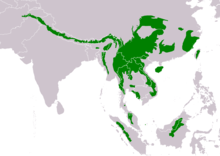Quail pygmy owl
| Quail pygmy owl | ||||||||||
|---|---|---|---|---|---|---|---|---|---|---|

Quail pygmy owl |
||||||||||
| Systematics | ||||||||||
|
||||||||||
| Scientific name | ||||||||||
| Glaucidium brodiei | ||||||||||
| ( Burton , 1835) |
The quail pygmy owl ( Glaucidium brodiei ), also known as the quail owl, is a small species of pygmy owl . It occurs exclusively in East Asia.
Appearance and voice
The quail pygmy owl reaches a body size of 15 to 17 centimeters. The head is gray-brown and has numerous whitish and ocher-colored spots. Feather ears are missing. The back is gray-brown with dark and lighter horizontal stripes. The species has showy white eyebrows and a white patch on the throat. There is an occipital face in the neck .
Distribution area and habitat
The quail pygmy owl inhabits the Himalayan region from northern Pakistan to China and Taiwan. In the southern direction of distribution it occurs over Malaysia to Sumatra and Borneo. It is a resident bird that inhabits submontane and montane forests. He mainly uses clearings, clear cuts and forest edges as living space. Its height distribution ranges from about 1,350 to 2,750 meters above sea level.
Way of life
The quail pygmy owl is diurnal and crepuscular. Even in bright sunshine you can occasionally watch him cross forest clearings and also hunt. Overall, it shows significantly less nocturnal behavior than a large number of other owls. Its diet consists mainly of small birds. He also beats mice, lizards, cicadas, grasshoppers, beetles and other insects. The ornithologists Claus König and Friedhelm Weick describe him as an extremely courageous and aggressive owl who sometimes attacks birds that are almost as big as they are.
In the Himalayas, the breeding season falls from March to June. He uses tree hollows as a nesting opportunity. The clutch usually comprises four white eggs.
supporting documents
Single receipts
literature
- Claus König , Friedhelm Weick: Owls of the World . Christopher Helm, London 2008, ISBN 978-0-7136-6548-2
Web links
- Glaucidium brodiei inthe IUCN Red List of Threatened Species 2013.1. Listed by: BirdLife International, 2012. Retrieved September 10, 2013.
